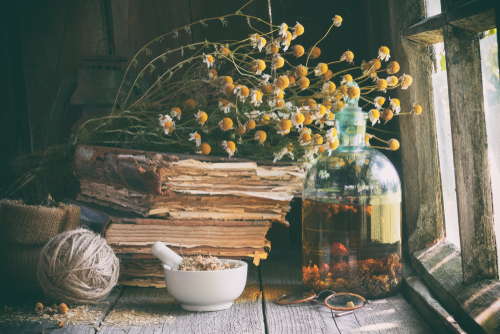A Path Grown in Green
Before books and study, before the names of compounds and Latin classifications, there was the earth. There was the garden behind the cottage, fragrant and wild, where the wind rustled through rosemary and bees danced among lavender spikes. Days began with the steam of steeping petals and ended with the hush of herbal sachets tucked beneath pillows. The herbs weren’t separate from life—they were life. Woven into meals, healing, grief, and joy.
Among the many plants that lined the worn stone walls and clustered beneath the kitchen window, three stood out as daily companions: chamomile, lavender, and rosemary. These were the gentlest teachers, welcoming to the curious and kind to the unsure. They remain perfect starting points for anyone drawn to the comforting rhythm of herbal care.
Chamomile: A Whisper Before Sleep
Chamomile speaks in softness. Its blossoms, resembling tiny daisies with golden hearts, are known across the world for their calming effect. Long before laboratories confirmed its properties, people knew chamomile brought comfort—to upset stomachs, to restless children, to grieving hearts. It has been brewed for centuries into warm teas, steeped in milk for skin-soothing baths, and gently pressed into poultices.
Even now, its familiar scent—sweet and apple-like—can bring a sense of safety. The active compound apigenin, studied for its mild sedative effect, supports the traditional use of chamomile as a sleep aid and anti-inflammatory. A warm cup of chamomile tea in the evening can feel like being wrapped in a beloved old quilt.
It is not dramatic or loud in its healing. It simply holds space for rest.
Lavender: The Breath Between
Lavender belongs to quiet rooms, sunlit fields, and linen drawers. Its scent is instantly grounding—floral and green, with a hint of something ancient. It has been used for centuries not just for its beauty, but for its ability to soothe the nervous system. In ancient Rome, it perfumed public baths. In medieval times, it was hung in homes to ward off illness and heaviness of spirit.
Now, science affirms what tradition has long held: the compounds in lavender, particularly linalool, influence the nervous system in ways that reduce anxiety and promote rest. Whether placed in a sleep sachet, diffused as an oil, or sipped in tea, lavender can bring stillness to even the busiest of minds.
One of the simplest ways to welcome lavender into daily life is to gather dried blossoms into small cloth bags. Tuck one into a pillowcase or drawer. With each breath, let its quieting presence work gently, without force.
Rosemary: The Steady Flame
If chamomile is the mother and lavender the grandmother, rosemary is the wise elder—the one with fire still in her bones. Upright and evergreen, with needle-like leaves and a sharp, clean scent, rosemary offers a spark of clarity. It has long been associated with memory and the mind. In ancient Greece, students wore rosemary garlands during exams. In folklore, it was planted near doorways for protection and remembrance.
Its name means “dew of the sea,” a reference to its fondness for coastal air. But rosemary grows well in many places, and once rooted, she stays—tough and generous. The scent alone has been shown to stimulate alertness and memory. The oils and extracts, rich in antioxidants like rosmarinic acid, are believed to support cognitive function and reduce inflammation.
Beyond medicine, rosemary lives in the kitchen. It lends its sharp green flavor to roasted vegetables, warm breads, and herbal oils. To make an infused oil, simply bruise fresh sprigs and steep them in olive oil on a sunny windowsill for a week or more. This oil, fragrant and warming, can be used both in food and as a massage oil for tired muscles.
A Moment of Care
Even the gentlest herbs deserve respect. Begin slowly. If there’s a history of allergies—especially to plants in the daisy or mint families—it’s wise to start with a small amount and notice how the body responds. Essential oils, though powerful and healing, should always be diluted before use on skin, and never taken internally without guidance.
And for those who are pregnant, breastfeeding, or managing ongoing health conditions, it’s always a good idea to speak with a knowledgeable practitioner before introducing new herbal routines. The goal is to nourish—not to rush.
Living With Herbs
You don’t need acres of land or years of knowledge to begin. A few pots on a sunny windowsill are more than enough. Chamomile, lavender, and rosemary are forgiving plants. They thrive with light, regular water, and a bit of attention. More than anything, they invite a slowing down—a way of observing the seasons, noticing scent and color, making time for ritual.
Even tending to a single plant can be an act of healing. Harvesting blossoms by hand, steeping them into tea, breathing in their scent—all these things root us in the present moment. And perhaps that’s what herbs offer most: not only their physical benefits, but their power to bring us home to ourselves.
Closing the Garden Gate
To begin working with herbs is not just to collect remedies—it’s to remember. To rejoin a thread of knowledge that stretches back through generations. There is something deeply comforting in knowing that the same plant growing on your windowsill once grew beside an ancestor’s door, offered to a child in distress, or tucked into the pocket of someone journeying far from home.
Let chamomile be your first cup. Let lavender scent your rest. Let rosemary sharpen your senses. And as these herbs become familiar friends, may they guide you gently into a life lived closer to the roots.



























